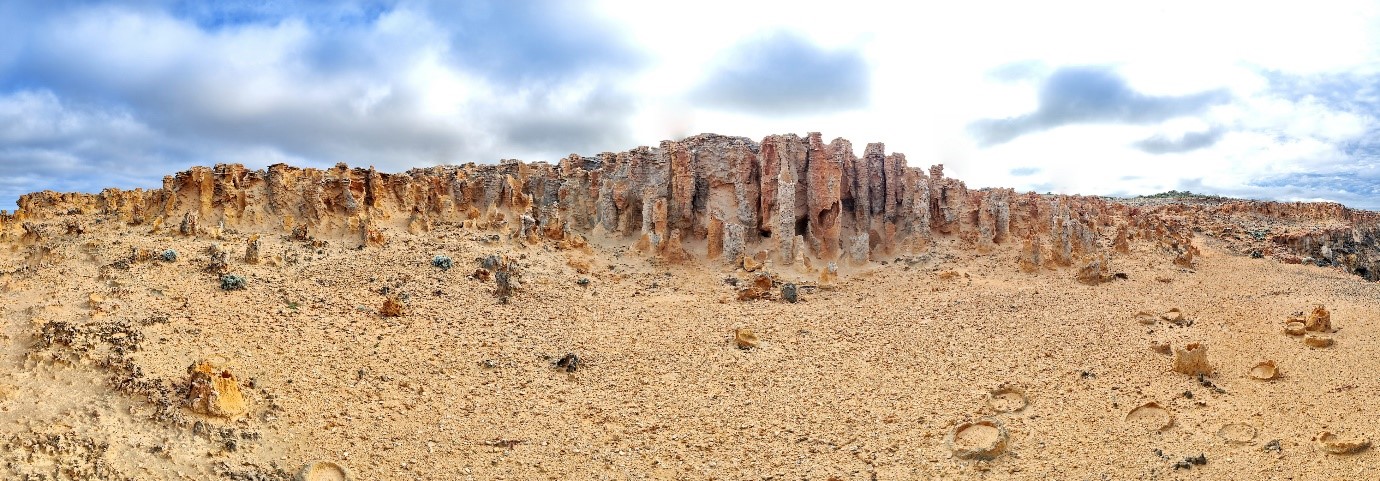Karst geomorphology

Karst geomorphology refers to a branch of physical geography that focuses on the study of landscapes shaped predominantly by the dissolution of soluble rocks, such as limestone, dolomite, and gypsum. These processes lead to the creation of distinctive features, including dolines, poljes, karren, and spectacular cave systems. The term "karst" itself originates from the Karst Plateau in Slovenia, where the limestone terrain and its characteristic landforms were studied in detail very early in history, giving rise to the term that is now used globally to describe similar landscapes.
Beside focussing into classical karst as we know in Slovenia, the Department also focusses in karst in Plio-Quaternary rocks, particularly in coastal calcarenites and aeolianites. This form of karst development offers unique insights into the interplay between geological, geomorphological and climatic processes over relatively recent geological timescales.
Understanding karst geomorphology is of importance both globally and for regions like Slovenia. Globally, karst landscapes host significant groundwater reservoirs, making them crucial for water supply in many areas. Their unique ecosystems and biodiversity, along with their striking geological formations, also make them key sites for scientific research, tourism, and conservation efforts. For Slovenia, where karstic features are an integral part of the national identity and natural heritage, understanding karst geomorphology is not only vital for managing and protecting its water resources and unique biological diversity but also for preserving its cultural heritage and promoting sustainable tourism that leverages its spectacular karst landscapes.
Recent projects:
- Denuded caves of the Nullarbor Plain - Slovenian Research and Innovation Agency - 2023-2026
- Karst doline networks in tropical island settings (Guam, USA) and temperate continental settings (Slovenia) - Slovenian Research and Innovation Agency - 2022-2024
- Solution pipes as a novel palaeoclimate proxy - Slovenian Research and Innovation Agency / Central European Science Partnership – CEUS – 2021-2025
- Geomorphological peculiarities of aeolianite karst and their palaeoclimatic significance - Slovenian Research and Innovation Agency - 2020-2022
- Geomorphological characteristics on eogenetic carbonate rocks in Slovenia and United States of America - Slovenian Research and Innovation Agency - 2019-2021
- Remote northern part of the Nullarbor Plain: using science to save nature - Australian Speleological Federation Conservation Fund – 2019-2020
- Karst artefacts of the remote northern part of the Nullarbor Plain - DEM Data Grant Project of TanDEM‐X Science, Microwaves and Radar Institute, the German Aerospace Center (DLR) – 2017-2023
Recent outputs:
- Ferk, M, Lipar, M, Šmuc, A, Parise, M, Ciglič, R, Cof, K, Miklavc, P, Stepišnik, U (2025). Detection of fossilised solution pipes and their hydrological function using electrical resistivity tomography in Apulia, Italy. Earth Surface Processes and Landforms, 50, doi: https://doi.org/10.1002/esp.70047
- Lipar M, Barham M, Adnišik M, Šmuc A, Webb JA, McNamara KJ, Šoster A, Ferk M, (2024). Ironing out complexities in karst chronology: (U-Th)/He ferricrete ages reveal wet MIS 5c. Science Advances 10. https://doi.org/10.1126/sciadv.adp0414
- Ciglič, R., Čonč, Š., Breg Valjavec, M. (2022): The Impact of Digital Elevation Model Preprocessing and Detection Methods on Karst Depression Mapping in Densely Forested Dinaric Mountains. Remote Sensing 14, 2416. https://doi.org/10.3390/rs14102416
- Čonč, Š., Tičar, J. (2024): Povezanost razporeditve jamskih vhodov in mikroreliefnih značilnosti kraškega površja: primer slovenskega Dinarskega krasa. GIS v Sloveniji 17, Digitalne vezi. Založba ZRC, str. 23-39. https://doi.org/10.3986/9789610508885_02
- Stepišnik, U, Ferk, M (2024). Morphogenesis and classification of corrosion plains in Slovenia. Acta geographica Slovenica, 64, doi: https://doi.org/10.3986/AGS.11774
- Lipar, M, White, S (2023). Quaternary Coastal Dune Limestone Karst. In: Australian caves and karst, Springer book, doi: https://doi.org/10.1007/978-3-031-24267-0
- Lipar, M, Ferk, M, Šmuc, A, Lavis, S (2022). Solution pipes in Bermuda. Envirotalk Newsletter, 86, link: https://environment.bm/s/Envirotalk-863-Autumn-2022-9285.pdf
- Gökkaya, E, Gutiérrez, F, Ferk, M, Görüm, T (2021). Sinkhole development in the Sivas gypsum karst, Turkey. Geomorphology, 386, doi: https://doi.org/10.1016/j.geomorph.2021.107746
- Lipar, M, Szymczak, P, White, S, Webb, JA (2021). Solution pipes and focused vertical water flow : geomorphology and modelling. Earth-Sceince Reviews, 218, doi: https://doi.org/10.1016/j.earscirev.2021.103635
- Lipar, M, Stepišnik, U, Ferk, M (2019). Multiphase breakdown sequence of collapse doline morphogenesis: an example from Quaternary aeolianites in WA. Geomorphology, 327, doi: https://doi.org/10.1016/j.geomorph.2018.11.031
- Lipar, M (2018). A combined approach to the study of Quaternary aeolian calcarenites for understanding the palaeoclimate. Geographical Bulletin, 90, doi: https://doi.org/10.3986/GV90105
- Lipar, M, Ferk, M, Šmuc, A, Barham, M (2022). Enigmatic annular landform on a Miocene planar karst surface, Nullarbor Plain, Australia. Earth Surface Processes and Landforms, 47, doi: https://doi.org/10.1002/esp.5459
- Barham, M, Lipar, M (2022). A giant ‘bullseye’ on the Nullarbor Plain was created by ancient sea life. The Conversation, link: https://theconversation.com/a-giant-bullseye-on-the-nullarbor-plain-was-created-by-ancient-sea-life-189125
- Lipar, M, Ferk, M (2022). Bihourly Subterranean Temperature and Relative Humidity Data from the Nullarbor Plain, Australia (Nov 2019–Mar 2021). Data, 7, doi: https://doi.org/10.3390/data7030030
- Burnett, S, Webb, J, White, S, Lipar, M, Ferk, M, Barham, M, O'Leary, MJ, Glover, FS (2020). Etched linear dunefields of the Nullarbor Plain ; A record of Pliocene-Plesitocene wind patterns across southern Australia. Palaeogeography, Palaeoclimatology, Palaeoecology, 557, doi: https://doi.org/10.1016/j.palaeo.2020.109911
- Lipar, M, Ferk, M, Lojen, S, Barham, M (2019). Sulphur (34S/32S) isotope composition of gypsum and implications for deep cave formation on the Nullarbor Plain, AU. International Journal of Speleology, 48, doi: https://doi.org/10.5038/1827-806X.48.1.2196
- Lipar, M, Ferk, M (2015) Karst pocket valleys and their implications on Pliocene-Quaternary hydrology and climate: examples from the Nullarbor Plain, south Australia. Earth-Science Reviews, 150, doi: https://doi.org/10.1016/j.earscirev.2015.07.002